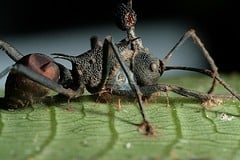Ant colonies attacked by the zombie-ant fungus can survive with the help of a second parasite that keeps the infectious spores in check.
The research, led by Penn State‘s David Hughes, reveals how the colony is able to survive infestations by the zombie-ant fungus, which invades an ant’s brain and causes it to march to its death at a mass grave near the ant colony, where the fungus spores erupt out of the ant’s head.
“In a case where biology is stranger than fiction, the parasite of the zombie-ant fungus is itself a fungus—a hyperparasitic fungus that specializes in attacking the parasite that turns the ants into zombies,” says Hughes. The research will be published in the journal PLoS ONE.
“The hyperparasitic fungus effectively castrates the zombie-ant fungus so it cannot spread its spores,” says Hughes, who is an assistant professor of entomology and biology, and a member of the Center for Infectious Disease Dynamics.
“Because the hyperparasitic fungi prevents the infected zombie-ant fungus from spreading spores, fewer of the ants will become zombies.”
As part of their research, the scientists created a detailed model that revealed previously unknown details of the interactions between the fungus-infected ants and the parasite-infected zombie-ant fungus. Scientists previously had known that ants defend their colonies against microscopic enemies such as fungal spores by efficiently grooming each other.
In this study, the researchers also modeled the effect of ant behavior on limiting infection. “Interestingly, beyond the well known effect of defensive ant behavior, our new research reveals the added effect of the castrating actions of the hyperparasite fungi, which may result in significantly limiting the spread of the zombie-ant fungus” Hughes says.
The scientists report that only about 6.5 percent of the spore-producing organs of the zombie-ant fungus were viable.
“Even though there are a lot of dead and infected zombie ants in the neighborhood, only a few of the spores of the zombie-ant fungus will become mature and able to infect healthy ants,” Hughes says.
“Our research indicates that the danger to the ant colony is much smaller than the high density of zombie-ant cadavers in the graveyard might suggest. This complex interaction between ant colonies, their brain-manipulating parasites, and other fungi capable of lending assistance to the colony underscores the need to study social insects under natural conditions.”
Hughes says his team is expanding its efforts and “remains focused on following the exciting theatre played out on the rainforest floor.”
The research was performed by an international group of scientists from University of Copenhagen in Denmark, Federal University of Vicosa in Brazil, and Penn State.
The research is funded by a Marie Curie OIF Fellowship, the Danish National Research Foundation, the Brazilian National Council for Research, and Penn State.

